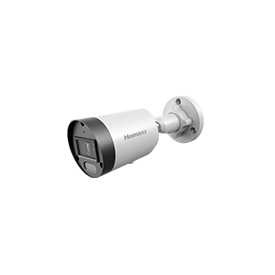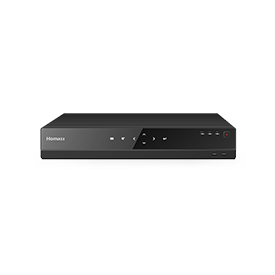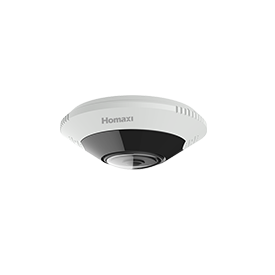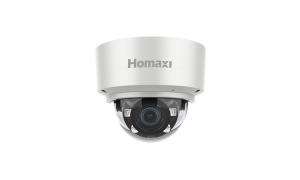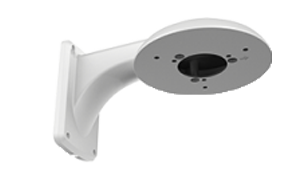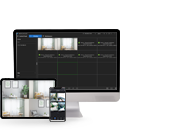Support
FAQ
1. Check if the IPC is disturbed by strong current
2. Check if the video cable contact is bad
3. Check if the power supply is connected correctly
You can use the “Vplayer” to play downloaded videos. You can download “Vplayer” from Support->Software & SDK->Tools.
1. Bad connection for the video cable
2. Check your own network environment
1.Check if the plug-in is correct.You can re-download the plugin.
2.Check if the device is multi-connected by others, check online users.
After I connected to the IP channel, there is no video output in the one*window or the multiple*window mode. But I can see there is bit stream.
There are following possibilities:
1. You can go to Set->Video/Audio->Video Settings to check the main stream/sub stream type of the camera is H.264 or not.
2. Check the device supports camera main stream/sub stream resolution or not (such as 1080P, 720P, 960H, D1, HD1 and etc.).
3. Check the camera setup. Please make sure It supports the products of other manufacturers.
4. Check if the plug-in is correct.You can re-download the plugin.
After I connected to the IP channel, there multiple*window output is OK, but there is no one*window output.
There are following possibilities:
1. Check there is video from the IP channel or not. Please go to the main menu*>info*>System*>BPS to view bit stream real*time information.
2. Check the main stream of the camera has been enabled or not.
3. Check the main stream type of the camera is H.264 or not.
4. Check the device supports camera main stream resolution or not (such as 960H, D1, HD1 and etc.).
5. Check camera network transmission has reached the threshold or not. Please check the online user of the camera.
After I connected to the IP channel, there one window output is OK, but there is no multiple window output.
There are following possibilities:
1. Lower, FPS, Bitrate, change CBR to VBR and set to sub-stream on some of the cameras.
2. Check the sub stream of the camera has been enabled or not.
3. Check the sub stream type of the camera is H.264 or not.
4. Check the device supports camera sub stream resolution or not (such as 960H, D1,CIF,etc.)
1. IR effect is bad.
2. There are limitations of how far the IR can reach. Please refer to the specifications of the camera.
1. Check if IE version is too low
2. Launch IE with administrator privileges
3. Check if permissions are allowed to install the plugin
1. Restore factory settings
2. Contact Technical Support
1. Run IE as administrator
2. Check whether IE permissions have allowed the plug-in to load
Log into the web interface, click Set and then choose the LocalSet.
1. Choose to turn off DHCP in the WEB web interface. Perform manual configuration
2. You can download “Homaxi Tool” from Support->Software & SDK->Tools.The “Homaxi Tool” will search any Homaxi products on the network and displays the information of the devices. This software can also be used to quickly configure the network information of the devices such as assigning a static IP address.
Note that the computer running the “Homaxi Tool” software must be on the same network (physical subnet) as the Homaxi device.
1. You can reset the device and log in via the initial IP.
2. Search by product model through “Homaxi Tool”.
Check for IP conflicts
1. Check for IP conflicts
2. Check PC Gateway is correct
3. Change the web address to “https”
1. Check the network environment is good
2. Check if there is a power failure or abnormal network connection during the upgrade process
3. You can also choose to upgrade manually
1. Check if the network environment is good and the network cable hole plug of IPC end is loose.
2. Check if the device is under normal power supply.
3. Check for IP conflicts
1. Camera damaged
2. Check whether the device can be pinged
3. Please check if your device and computer are in the same network segment
4. Change the web address to “https”
1. Check if the power supply is connected correctly
2. Check the ambient temperature
3. Replace the power adapter
1. Select Set-> System-> Auto Reboot
2. Click the Reboot
1. Select Set
2. Select Video/Audio
3. Select OSD to set
1. Log into the IP camera using the web browser,
2. Select Set
3. Select Basic Settings,
4. Select Time&DST to change.
1. Log into the IP camera using the web browser,
2. Select Set,
3. Select Basic Settings,
4. Select Time&DST to change.
Tell technical support the model number of the device you want to upgrade
1. You can upgrade online.You can login to the device web interface, click Set→System→Upgrade→select upgrade file→Upgrade
2. You can choose to upgrade manually. You can do this manually by going to Support->Firmware->IPC and downloading the appropriate upgrade package.
3. You can ask technical support for an upgrade file, and you can use the upgrade file to upgrade in “Homaxi Tool”.
1. Remove the back cover of the camera, there is a small button inside, long press to reset the device
2. Login to the web terminal and click Set→System→Default settings→”Restore factory reset”Execute
Restore the default and reconfigure
1. You can download “Homaxi Tool” from Support->Software & SDK->Tools.
2. Launch the tool and click Search
3. Find IP by device model
1. Check if the power supply is normal
2. Contact Technical Support
1. Please ensure that the upgrade package matches the device model.
2. Please check if your device and computer are in the same network segment.
1. Check if the SD card status is set as read only status, if so; you need to change it to read/write status.
2. Check if the SD card can be detected.
3. Check if the SD card has been damaged.
4. Check if the SD card is full, if it shows that the residual space is 0, you can format the SD card.
5. Check if the model is compatible with an SD card.
1. The SD card is not installed properly
2. It is possible the SD card is bad. Try the SD card in other devices to see if it is recognized. It is possible the connections of the SD card are damaged.
1. Check if the day/night switch is configured to automatic mode
2. Check current time and device time
3. Reset device
You can use the “Vplayer” to play downloaded videos. You can download “Vplayer” from Support->Software & SDK->Tools.
1. Check if the recording schedule is configured.
2. Check if the associated actions are configured
1. The device does not have a memory card.
2. The SD card is not installed properly.
1. The default IP address:192.168.1.9 or get an IP address through DHCP.
2. The default username: admin.
3. The password set during activation.
1. The network bandwidth is not sufficient. The multiple-channel monitor operation needs at least 100M or higher.
2. Your PC resources are not sufficient. For 16-ch remote monitor operation, the PC shall have the following environment: Quad Core, 2G or higher memory, independent displayer, display card memory 256M or higher.
1. There may be an IP address conflict.
2. Check the IP address is Blocked Sites or out of Trusted Sites.
1. There may be an IP address conflict.
2. Check the PC gateway is correct.
3. Attempt to use Https for access.
1. Check your network environment is normal.
2. Check P2P Status: Success.
3. Check the device P2P function is enabled.
4. Check P2P Cloud ID and Verification code is right.
1. Check the cable connection from the system to the router/modem.
2. Your router or modem maybe failing and needs to be replaced.
3. Check for DHCP and static IP address.
4. Check MAC address.
1. HDD cable connection is loose.
2. Insufficient power.
3. HDD is not compatible.
4. HDD is broken.
1. Not enough free memory on the USB device, please change backup device.
2. If Backup device is damaged, please change backup device.
1. Setting the NVR to record only on motion.
2. Reducing quality’s frame rate, Resolution and Maximum bit rate will increase the recording time to the existing hard drive of the recorder.
1. Check that the HDD is working and is detected by NVR.
2. Check, “Schedule” in “Storage” and ensure your desired recording is enabled; Normal, MD, Alarm.
3. Recorded file has been overwritten.
1. Ensure “Motion Detection” is enabled on each camera, applied, and saved.
2. Ensure the schedule in “Motion Detection” is set for motion recording.
3. Ensure the “Record Channel” in trigger process config is checked off.
4. If you want to record more, you can go to “Storage” to set up a recording schedule.
1. Check the cable connection from the system to the router/modem.
2. Your router or modem maybe failing and needs to be replaced.
3. Check for DHCP and static IP address.
4. Check MAC address.
1. “No resource” usually indicates that the NVR’s graphical display has reached its limits.
2. You can resolve this by re-adjusting the video settings of the displaying camera channels.
3. Reduce the resolution/fps/max bitrate settings for either mainstream and or sub streams of the camera.
1. Check that the network connection to the camera.
2. IPC may undervoltage during restart.
3. HDD failure.
1. If There is no video input signal or it is too weak, due to the length of cable, find shorter cable.
2. If Not enough bandwidth then check internet.
3. Check if you are using You are using aluminum braid or copper braid cable and change if not.
4. Check the POE switch or centralized power supply
5. Firmware may be old. Please upgrade to the latest version.
1. Check that the network connection to the camera.
2. Check with camera username and password.
3. Check the camera connection protocol.
4. Firmware may be old. Please upgrade to the latest version.
1. NVR is in the normal startup state.
2. Check the resolution can be restored through the WEB or by pressing the left and right mouse keys together.
3. Check whether VGA output is normal.
4. The device is faulty, contact technical support.
1. Check IPC support audio input.
2. Check the opening of NVR audio.
3. Check the NVR audio output line is properly connected.
4. Check the sound box can work normally.
1. Log in to the NVR Web page to upgrade.
2. Upgrade with Homaxi Tool.
3. Upgrade via VMS.
1. Check that IPC is a Homaxi product.
2. Check that the IPC protocol is a private protocol.
3. Check that IPC itself supports modification.
1.Check whether IPC supports it and has started to enable it.
2. Check the SMD and PP detection area has been set.
3. Check that the configuration is saved correctly.
1. Find the alarm item, check the alarm condition, and check whether it is triggered all the time.
2. Whether the device breaks down.
3. Software BUG, Contact technical support.
1. The NVR is warning about an issue or event that it is programmed to notify about.
2. Common issues for the NVR beeping are the following: HDD in error state, IP address conflicted, Network disconnected …
1. Setup is not correct,Configure the NTP and NTP server.
2. Time-corrected by another device.
3. Battery contact is not correct, or voltage is too low.
1. Check if the UVC is powered on normally
2. Check if the video cable is connected correctly
3. Check if the UVC video protocol of the UVR channel is configured correctly
192.168.1.9
The Preferred DNS Server should not be blank and a public DNS server assigned.
1. Not enough free memory on the USB device, please change backup device.
2. If Backup device is damaged, please change backup device.
1. Check if IE version and compatibility are adapted.If IE version is too low, you need to upgrade.
2. Check IE security site settings.
3. Whether IE process is occupied during installation.
1. Change the IP address via the UVR web page or locally.
2. You can download “Homaxi Tool” from Support->Software&SDK->Tools.The “Homaxi Tool” will search any products on the network and displays the information of the devices. This software can also be used to quickly configure the network information of the devices such as assigning a static IP address.
Note that the computer running the “Homaxi Tool” software must be on the same network (physical subnet) as the Homaxi device.
1. Log in to the UVR Web page to upgrade.
2. Upgrade with “Homaxi Tool”.
3. Upgrade via VMS.
1. “No resource” usually indicates that the UVR’s graphical display has reached its limits.
2. You can resolve this by re-adjusting the video settings of the displaying camera channels.
3. Reduce the resolution/fps/max bitrate settings for either mainstream and or sub streams of the camera.
1. The UVR is warning about an issue or event that it is programmed to notify about.
2. Common issues for the UVR beeping are the following:HDD in error state, IP address conflicted, Network disconnected …
1. Setting the UVR to record only on motion.
2. Reducing quality’s frame rate, Resolution and Maximum bit rate will increase the recording time to the existing hard drive of the recorder.
1. The video stream is not available. Check if there are many devices connected to the camera.
2. If the multi window output is blank, then check the main stream encoding type of the camera is H.264 or not (Main Menu->Remote Device->Encode). Solution: the encoding stream was setup incorrectly and needs to be H.264.
3. Check whether HDMI or VGA output is normal.
4. The device is faulty, contact Technical Support.
1. Check that the network connection to the camera.
2. Check with camera username and password.
3. Check the camera connection protocol.
4. Firmware may be old. Please upgrade to the latest version.
5. Brightness is 0. Please adjust the brightness of the camera.
1. If There is no video input signal or it is too weak, due to the length of cable, find shorter cable.
2. If Not enough bandwidth then check internet.
3. Check if you are using You are using aluminum braid or copper braid cable and change if not.
4. Check the POE switch or centralized power supply
5. Firmware may be old. Please upgrade to the latest version.
6. Brightness is 0. Please adjust the brightness of the camera.
1. Check that the UVR is switched to the IPC channel
2. Check that the IPC and UVR are connected.
1. Check whether the UVC is normally powered on;
2. Check whether the UVC video protocol is correctly configured
3. Check the video cable
4. Check whether the channel is cut in the IPC channel
Currently, the Homaxi View Application isavailable for iPhone and Android phones.
You can download the Homaxi View Application from the Appstore (for iPhone) and Play store (for Android).
1. Check the device network;
2. Check the mobile phone network;
3. Check the cloud service;
4. If the problem is still not solved, please contact technical support.
1. Check if the device has been added successfully.
2. Check the device or mobile phone network.
3. If the problem is still not solved, please contact technical support.
1. Check the save path configuration;
2. Check the read/write permission of the disk where the path is located.
1. Confirm that the upgrade package is correct;
2. Confirm that the device is normally online.
1. Check if the device is online;
2. Check device account permissions;
3. Check the compatibility of the PC graphics card driver;
4. Delete the device and re-add it.
The combination of frame rate and resolution based on the type of compression will need bandwidth necessary to accomplish. The higher the resolution/frame rate combination the more bandwidth or bit rate is necessary. The link below is to a bit rate chart that discusses in greater detail.
H.264+ Bit Rate Chart
Mainstream: is the primary video feed. Mainstream provides the highest video quality, and is the stream the DVR / NVR uses when saving footage to the internal hard disk drive (HDD). Mainstream settings can be adjusted to increase or decrease recording resolution. These settings will impact recording file size and available recording time. Hard Disk Drive (HDD)
Sub-stream: is the secondary video feed. Sub-stream provides a lower quality video stream, and is typically used to stream video to computers, smartphones, or tablets over the Internet. This allows you to reduce streaming quality for live or remote viewing, while maintaining higher quality on the mainstream for HDD recording and storage.
When is each one used?
Mainstream: is the primary video feed mainly use for recording..
Sub-stream: is used mainly for remote viewing from computers, smartphones, or tablets over the Internet from outside the network..

